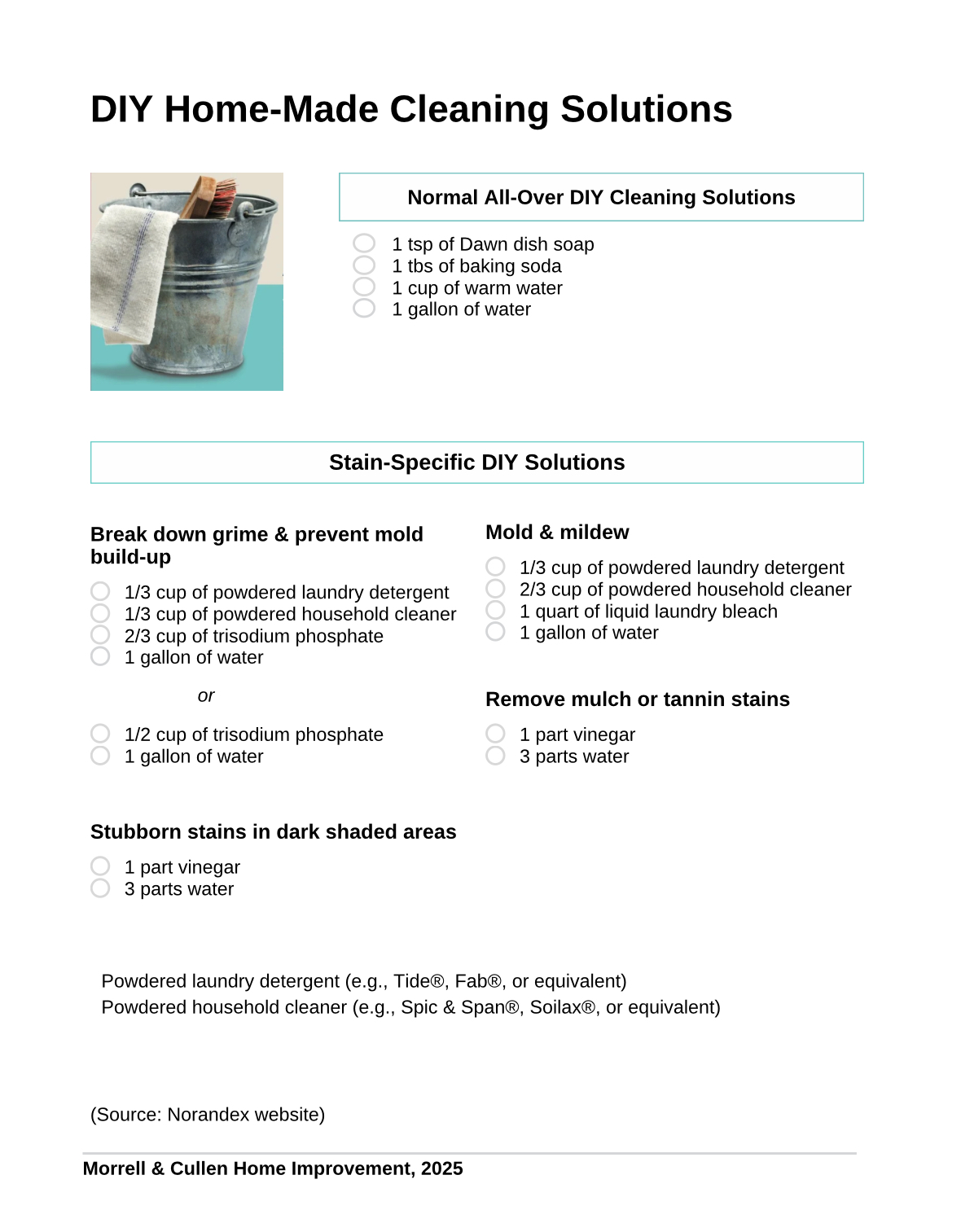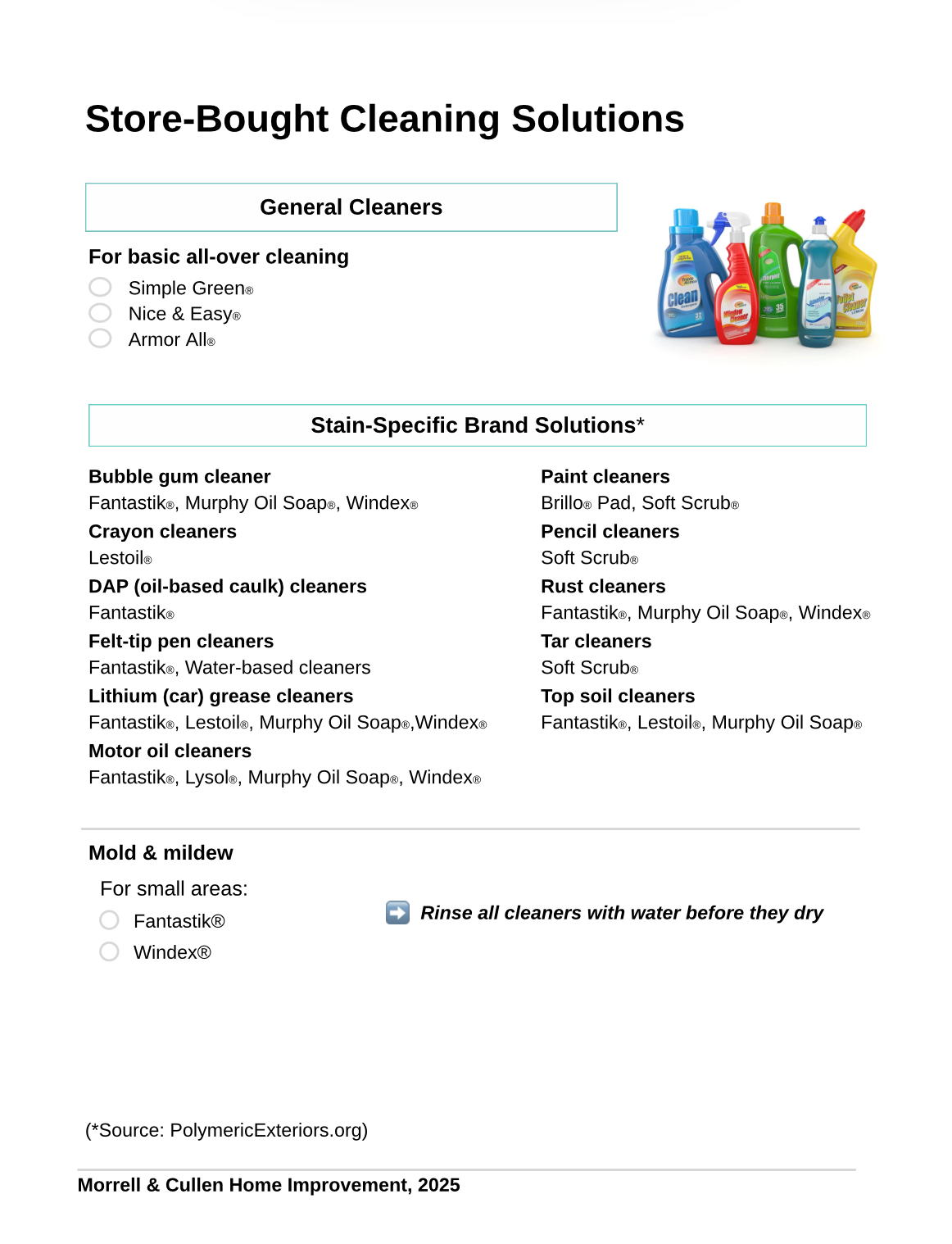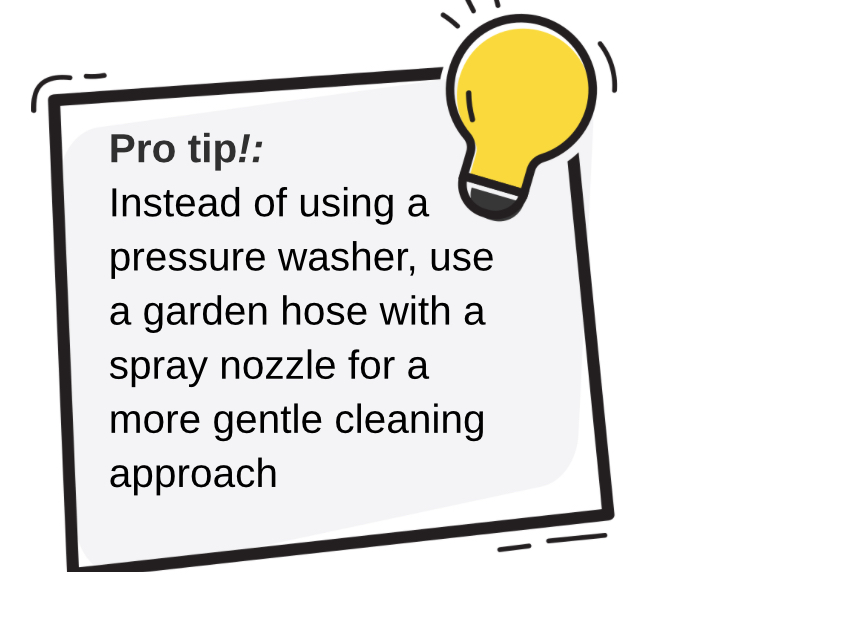Vinyl Siding Care & Maintenance

At Morrell & Cullen Home Improvement, we believe that homeowners deserve the tools and knowledge to protect their investment long after installation day. That's why we promote preventative maintenance—simple, proactive steps that help identify potential concerns early, before they become costly repairs. By taking a little time each season to observe, clean and maintain your siding, you not only enhance curb appeal and protect your siding but also help ensure your manufacturer warranty remains intact.
To help keep things as easy as possible for our customers, we’ve created a Proactive Maintenance Plan to help give you the tools, knowledge and support to protect your home with confidence.
Proactively Caring for Your Home
Most siding damage doesn't happen overnight—it builds slowly, often unnoticed until it becomes something bigger and costlier. Our Proactive Maintenance Plan was created to change that. Through easy cleaning checklists, photo-based evaluations and professional feedback, our Proactive Maintenance Plan encourages a preventative approach to home care—one that protects not just your siding, but the overall health and longevity of your home. It's one more way we're committed to helping homeowners stay informed, empowered and one step ahead.


Key Part 1
• Routine Cleaning
Required Tools:
- A bucket
- Wash cloth, sponge or soft bristled brush*
- Garden hose w/spray nozzle
- Store bought or DIY cleaning solution
- Extension handle (for brush) - optional
*For siding with a textured surface, a soft bristled brush is recommended
Routine cleanings are recommended at least twice a year, if not seasonally. Fortunately, cleaning your vinyl siding is straightforward and easy to follow:
- Start with a rinse. Using a garden hose with a spray nozzle, pre-rinse your siding to remove loose dirt, dust and cobwebs from its surface. Start at the top and work your way downward, moving in a steady, side-to-side motion.
- Take care not to blast water upwards causing it to get underneath the siding panels - Prepare a mild cleaning solution. See the list of acceptable store bought and DIY cleaners below and prepare a bucket of your preferred solution.
- Scrub gently. Divide siding into 10 ft. sections. Using a soft-bristle brush, sponge or wash cloth, gently scrub the first section, working from the bottom-up to avoid streaking. Be mindful not to use anything abrasive that could scratch the surface.
- Rinse thoroughly. Immediately after scrubbing, rinse the entire section, top-to-bottom, with clean hose water before moving on to the next section to ensure no soap or debris dries on the siding.
- Inspect as you clean. This is where the 2nd part of siding maintenance comes in to play. While working, check each section for any visible signs of the conditions that are listed in the Vinyl Siding Inspection Checklist below. - Take notes or photos of anything that looks unusual. Either call to have us come take a look at it or use our SNAP My Siding tool to get quick, professional feedback.
- Repeat steps 3-5 for each section.



Things to Avoid to Maximize the Life of Vinyl Siding
Steel wool, wire brushes, or paint scrapers
Abrasive tools can cause scratches and permanent damage to vinyl
Cleaners containing organic solvents
Cleaners with organic solvents or other aggressive ingredients can affect the surface appearance of vinyl. (Examples of such cleaners are: chlorine bleach, liquid grease remover, strong soaps and detergents containing organic solvents, nail polish remover, furniture polish/cleaners)
Dark Shredded Wood Mulch
Dark shredded wood mulch creates the perfect environment for artillery fungus—a naturally occurring fungus that shoots tiny black spores that are extremely difficult—or sometimes impossible—to remove without damaging the surface. Even when cleaned, they often leave permanent stains. Lighter-colored mulches, especially stone, bark nuggets, or non-organic options, are much less likely to harbor artillery fungus, making them a safer choice for protecting your home's exterior.
Painting Vinyl Siding
We highly advise against painting vinyl siding, as it can void the manufacturer's warranty, trap heat, and compromise the material's ability to expand and contract properly.
Cleaning Two-Story Homes & High Spots: Two Tools to Avoid
Ladders
Cleaning two-story homes or high spots doesn't have to involve the use of ladders. In fact, unless you're a seasoned ladder user, we highly advise against it. Not only is attempting to clean siding from a ladder a serious safety hazard, but leaning a ladder against your house can cause dents and seriously damage siding panels.
Pressure-Washers
Additionally, the use of high pressure-washers should also be avoided whenever possible. They can compromise vinyl siding's protective sealant, speeding up oxidation and leaving potential uneven, blotchy marks on the surface. The forced pressure also increases the risk of getting water underneath the siding panels, causing moisture to accumulate and lead to mold, mildew and rot. More importantly, using a pressure washer voids most manufacturer's warranties, making it one of the most common causes for claim denials. If you do opt for a pressure-washer, be sure to use one with a wide-angled nozzle and a gentle setting. Pressure-washers should always be used with care as The Center for Disease Control and Prevention forewarns that they carry risk of injury or electric shock

Protecting Vinyl Siding From
Discoloration
To prevent discoloration, be sure to cover vinyl siding when using stains, sealants or wet concrete during other renovation projects.
Some insecticides and herbicides can also leave stains, so always read the product labels or consult the manufacturer before applying them near your home.When landscaping, choose light-colored mulch to minimize tannin staining and reduce the risk of artillery spores attaching to the siding.
Heat
Vinyl siding is made from organic materials and can melt when exposed to a significant heat source. And although it’s a combustible material, it won’t readily ignite unless exposed to flames from an existing fire. Home and building owners with all types of siding should always take precautions to keep heat sources such as barbeque grills, and readily ignitable materials such as dry leaves, mulch and trash away from the structure. Dryer vents should also be redirected away from vinyl siding.
Reflected Light
In some cases, intense heat damage to vinyl siding can occur when solar light is abnormally concentrated by reflections from nearby windows. While normal flat window glass typically doesn't generate enough heat to distort siding, certain energy-efficient windows can slightly curve over time, acting like a mirror and focusing sunlight onto a small area. This concentrated heat can exceed what vinyl siding—and even other common building materials—are designed to withstand. The best solution depends on the situation, but the goal is to block or diffuse the reflected sunlight. This can be achieved by planting trees or shrubs, installing awnings or sunshades or applying window screens to reduce reflected energy.
Vegetation
Keep trees and bushes trimmed at least 6” away from your house to prevent direct contact with vinyl siding. During warmer months, fast-growing plants and vines can press against siding, trapping moisture and promoting mold or mildew. Maintaining this proper clearance ensures airflow, reduces moisture buildup and helps protect your siding from long-term water damage.
Key Part 2
• Preventative Maintenance
A quick visual inspection at the change of each season is one of the simplest yet most effective ways to protect your vinyl siding. Weather shifts, landscaping growth and outdoor activity can all impact your exterior in small ways that may go unnoticed day-to-day. By routinely checking for loose panels, hairline cracks, discoloration, warping or gaps around windows and doors, homeowners can stay aware of subtle changes before they become problems. Seasonal observation doesn't require tools or professional training—just attentive eyes and a proactive mindset.
You can use our two checklists below as a guide.
And if you’re an existing customer and we installed your siding, try out our free “SNAP My Siding” tool that allows you to easily submit your siding photos to us and receive prompt professional feedback in return.


Step 2 - Early Intervention
While regular inspections and observations are important, they’re only half of the equation. The second step involves professionally assessing observations and taking prompt action if necessary - a process that’s rarely stressful or expensive. In fact, it’s intended to do the opposite. When minor issues are caught early, they are typically fast, affordable and easy to correct. But when small cracks, moisture buildup or loose panels go unaddressed, they can quickly escalate into larger, more expensive concerns like water intrusion, rot, energy loss or pest damage.
Additionally, early intervention not only preserves the structural integrity and appearance of your home, but it also helps maintain manufacturer warranty coverage by proving that the siding has been properly cared for. Simply put, acting sooner rather than later is one of the smartest investments you can make in your home's long-term health and value.
Replacement Siding Panels
Even with the best siding maintenance habits, repairs may be necessary from time to time. Fortunately, vinyl's modular design allows for easy replacement of individual siding panels so that entire walls don't need to be replaced for the sake of just one or two. If a panel becomes faded, warped or cracked, just give us a call and we'll come take care of it for you within the next few business days.
Helpful side-note for when you call: Let us know if you have any spare siding panels set aside (when possible, we leave you with a few extra siding panels incase any need to be replaced in the future). If you don't have any on-hand, it's helpful for us to know that ahead of time so we can be sure to bring some with us before we stop over. Some siding panels are easier to obtain then others. Custom replacement siding panels may need to be ordered ahead of time.
Helpful Downloads & Resources
Created Specifically for Morrell & Cullen Home Improvement Customers


